Festa del Soccorso
One of the craziest celebrations in the World.
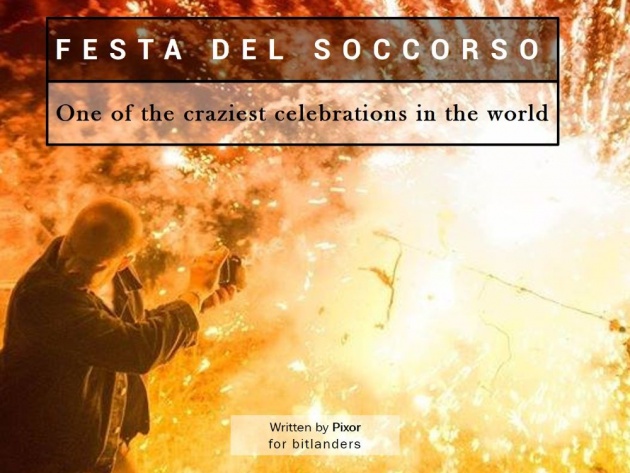
Image edited by Pixor
Hey, bitfellows. During these days I had no time to blog, as in my city there were the celebrations in honor of our Patron Saint: The Lady of the rescue. It is the most awaited event in San Severo, not only by the citizens but also by several tourists who come to San Severo every year to join the celebrations.
In this blog I'll tell you everything about this event: when was it born? How is it structured? Why is it this way? Are you ready? Let's go.
Video Credits:
San Severo Web Via YouTube
A brief story of San Severo
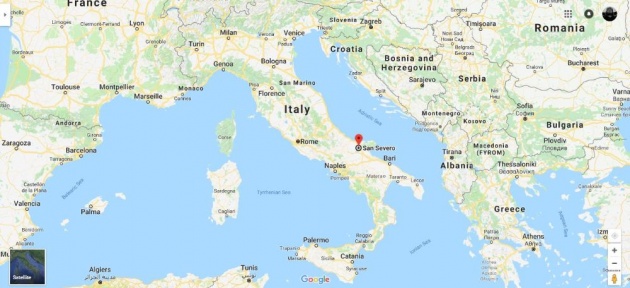
Image Credits: GoogleMaps
San Severo is the city where I was born and where I live in currently. It has more than 55.000 inhabitants and it has always been an important city in Capitanata, that is the most northerly part of Apulia, the "heel" of Italy. According to the legend, San Severo was founded by the Greek hero Diomede with the name "Castrum Drionis" and it remained pagan till 536, when the bishop of Siponto sent in the city Severus (Severo in Italian), a governor who was converted to the Christianism by him.
However, according to the documents, San Severo was born around its first Church between 1100 and 1200 as a fortified town named Castellum Sancti Severini, that means "fortified town of Saint Severinus"; its strategic position on the way towards the cave of Saint Michael (in Monte Sant'Angelo) and the proximity to the river Fortore made it one of the most important cities in Apulia. Several and different populations settled in San Severo: Venetian, Florentine, Saracen and Jewish merchants. In 1230, San Severo lost its boundary walls, as it rebelled to the Emperor Frederick II of Swabia and in 1250 he ceded it to the Knights Templar.
During the XIV and XV century, it was swapped several times from one governor to another till 1491, when it obtained the municipal statute and the title of royal city. Thanks to the administrative independence, it could make its own money too.
During the XVI century, it became a province and when King Charles V sold it to the Duke of Termoli, Tiberio Solis, one of the Mayors, bought its freedom with 42.000 ducats, collected among the noblest families of the city and the Neapolitan bankers. The king, in 1536, established the oligarchic Regime of the Forty and ennobled twenty-four local families. During this period San Severo was the most populated city in the zone and it had a huge traffic of merchants, politicians, cultured persons and ecclesiastics, thanks to the huge amount of businesses, the cultural vitality and the administrative autonomy.
In 1579, the city was sold to the Duke Gian Francesco di Sangro, who obtained for his heirs the title of princes of San Severo, as the city couldn't pay the debt with the Neapolitan bankers. It lost the title of chief town and the Regime of the Forty was dismantled. Despite this event, it became the episcopal seat, before the earthquake that destroyed it almost totally and killed 800 people.
During the XVII century, the plague killed more than 3000 people and the reconstruction of the city was very slow.
It flourished again in the XVIII century as a markedly Baroque city. The Spanish king and queen came to visit it and they participated in a mass in the Cathedral. In 1799 the French troops, commanded by the generals Duhesme and La Foret, ransacked the city in a very violent way. The victims, between citizens and soldiers, were about four hundred and fifty.
During the XIX Century, the Real Bourbon theater was inaugurated. The city became a crucial stronghold of Carbonari and masonry, the secret societies that paved the way to the process of unification of Italy; the citizens were so much revolutionary that the revolutionaries thought for a long time about the idea of making San Severo the starting point of the 1820 uprisings.
In 1860 San Severo contributed with many young people to increase the ranks of the Garibaldians and, when King Francis II, was still on the throne, it was the first city of Capitanata to proclaim the Kingdom of Italy and to hoist the tricolor flag.
The Lady of the rescue

Image Credits: Pixor Via bitlanders
The cult of the Lady of the rescue has been due to the Augustinian monks, who lived in a monastery in San Severo since 1319; at a certain point, they got away from the city and settled in Sicily. During that period they known that the Lady appeared to a Sicilian Augustinian monk in 1306 and since that moment they venerated her; when they came back to San Severo, in the sixteenth century, they brought the cult of the Lady of the rescue with them. The Statue arrived from Palermo in 1564; she was made with the ebony wood and that's why she is black.
As the economy of San Severo was strictly linked to the agriculture, The Lady was immediately invoked whenever there were drought and scarce crops and that's why her statue holds in her right hand some spikes, an olive branch and a bunch of grapes: the three products at the base of the agriculture of San Severo. She holds a baby in the other arm.
During the XVIII century, when the Augustinian monastery was definitively suppressed, the local landowners kept the cult of the Lady alive; they were used to bring the statue in a procession right in the middle of the crops. They gathered in a brotherhood in 1679 and it became an archconfraternity in 1870.
The cult of The Lady raised during the XIX Century in parallel to the social ascent of the class of the landowners and she was elected Patron Saint together with Saint Severinus and Saint Severus. The original baby was substituted twice and all the people who received a miracle dressed her with precious fabrics, woven of gold threads and decorated with jewels.
The celebrations
Before The Lady of the rescue became the patron saint of the city, there was only one procession during the year: the one of Saint Severus; however, when she had been elected co-patron saint of San Severo, the procession of Saint Severus became also the one of The Lady of the rescue. After, when she had been elected as the principal patron saint, the procession of Saint Severus became the one of The Lady and it was moved on the third weekend of May. It's a big celebration, the Lady of the Rescue is always in the middle, on her right, there is Saint Severus, bishop of Naples, and on her left Saint Severinus, who protected the city twice! During the path, as the Lady arrives in a new neighborhood, the procession stops and the fireworks made by that neighborhood are burned. Each neighborhood is in a competition with all the other ones in the city: in fact, each one fights to create the best firework and win the cup. Lately, the best neighborhood is the one called Porta Lucera, whose biggest rival is the one of Via Sicilia. Sometimes, the neighborhood of Via Fortore can really surprise everyone for the power of its fireworks and for the aesthetic factor. The celebrations last for three days:
Saturday
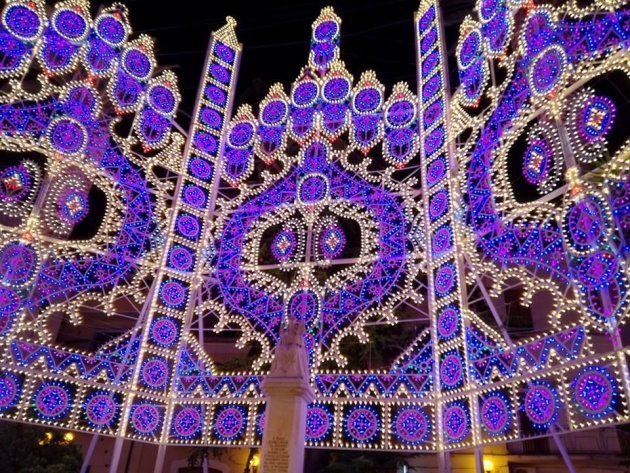
Image Credits: Pixor Via bitlanders
On the eve of the third Sunday of May, at midday, the statues are dressed for the procession with their rich and gorgeous dresses and arranged on the stretchers made of golden wood. The Lady is adorned with a golden crown and the most precious jewels kept in the Treasure room of the Sanctuary.
In the early afternoon the simulacra of the Guardian Angel and of the holy archangels Raphael, Gabriel and Michael are brought to the Cathedral from the Sanctuary of the Lady. Later a solemn mass is celebrated in Piazza Incoronazione, one of the most important squares in the city. At sunset, the illuminations are lit. They illuminate the most important streets of the city and, in particular, Piazza Incoronazione, where there is the largest illumination, whose highness reaches approximately fifteen meters.
Sunday

Image Credits: Pixor Via bitlanders
On Sundays, at ten o'clock, the solemn procession begins. There are the bishop, the diocesan clergy, the Archconfraternity of the Lady (recognizable by the blue capes), the pious association of Saint Severinus (with yellow capes lined with red), the "bearers" of Saint Severus (with red capes lined with yellow) and the ones of the Angels (with blue capes lined with white), then the civil and military authorities.
The banner of the Lady opens the procession. Then there are the simulacra of the four Angels and the patron saints: Saint Severinus on the left and Saint Severus on the right; behind them, The Lady of the rescue is in the middle. After the simulacra of The Lady, there are the large white canopy made of silk and embroidered in gold, and the gonfalons of the city and the province. At the end of the procession, two bands alternate, ringing incessantly.
After a short tour through the ancient borough, the procession, which lasts more than six hours, continues through the entire "Giro Esterno", that is the long ring road corresponding to the ancient medieval walls, and then returns to the cathedral.
Monday
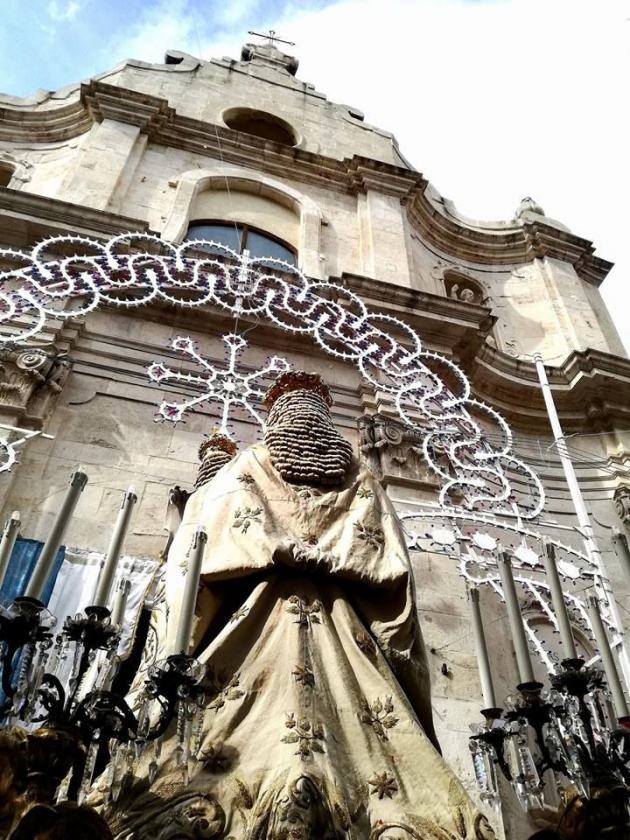
Image Credits: Pixor Via bitlanders
On Monday, the procession is less luxurious: there aren't the civil and religious authorities and the simulacra of the Angels return to the Shrine of Our Lady before the beginning of the procession. So, there are the three Patron Saints, preceded by the banner of the archconfraternity and followed by the canopy and two bands.
Although the procession is less pompous, on the other hand, the itinerary is longer, so that the duration of the procession exceeds seven hours (approximately from 10.30 to 18.00).
At the end of the route, the statue of the Lady of the rescue returns to her Sanctuary, passing among the simulacra of the two patron saints that are arranged at the sides of the portal. After that the effigy of the Virgin is entered into the Sanctuary, those of St. Severinus and St. Severus continue together their route toward the cathedral, where Saint Severus retires. The last part of the procession, finally, coincides with the joyful return of the statue of Saint Severinus to his church, accompanied by the cheering crowd and the particularly lively marches, played by the bands.
Tuesday
On Tuesday, usually, a concert puts an end to the celebrations. Several Italian artists came to San Severo to sing, a lot of them were very famous, like I Nomadi, Anna Tatangelo, Dolcenera, I Pooh, Umberto Tozzi, Matia Bazar and more. Furthermore, on Tuesday the carousels go away from the city, among the sadness of the kids and the happiness of those people who live nearby the area dedicated to them (LOL :D).
Le "batterie" (the fireworks)

Image Credits: Pixor Via bitlanders
The Fireworks of San Severo, know as "batterie" or "fires" are similar to the Valencian mascletás; they're sequences of explosions characterized by different intensity and form. At morning there are the ones "alla sanseverese" (at the way of San Severo), which are the classic ones; at night, there are the ones "alla bolognese" (at the way of Bologna), which are super colorful.
All of them respect a precise structure: in the beginning, there is a "rotella" (little wheel), a little metallic circle on which there are fuses that produce little explosions and isolated plays of light and noise.
After that, the run begins, since the "batteria" is burned. It is made of a long fuse, on which a lot of powerful fireworks are attached; when the point of the fuse at which they are attached burns, they explode in a rhythmic succession. For each series of regular explosions (generally sixteen), there is a stronger one, called "risposta" (response); and every three "risposte" a more violent bang, called "quinta" (the fifth) or also "ripostone" (big response) or "calcasso", deflagrates. Between one "risposta" and the one that comes after there are blazes, fire fountains, simultaneous parallel explosions, accelerations of the "risposte" and squashing brakings, characterized by violent cadenced explosions of "quinte"; everything goes in crescendo towards the last section of the "batteria", the "final" (or "the run"), that is the fastest and strongly rhythmic one, characterized by real roofs of fireworks, parallel paths and crossing sections, which increases up to the last big detonation.

Image Credits: Pixor Via bitlanders
The tradition of the fireworks is ancient, the first written document in which there is an explicit reference to the fireworks dates back to 1707 but it's pretty sure that the first fireworks were introduced starting from the second half of the XVII century. Another document dated back to 1748 explain the difference between the fireworks with five thousand bangs and the ones with three thousand bangs, a clear sign that the technique of production of the fireworks was already advanced.
Time after time, the fireworks have become the galvanizing and irreplaceable concert that is the soundtrack of the celebrations. Starting from the first half of the XX century, a further spectacular element has enriched the celebrations: the "fujenti's" race (the runners. It comes from the dialectal verb fujë = to run). A huge number of people every year runs next to the fireworks, defying the sparks and the fiery paper, chased by the increasingly strong and fast deflagrations until the final. They give life to a spectacular and adrenaline collective run, a Dionysian escape from death, pain and Evil that, in the ancestral roller of the explosions, is all a hymn to the most authentic joy of living and an act of redemption from all the sins, under the gaze of the patron saints.
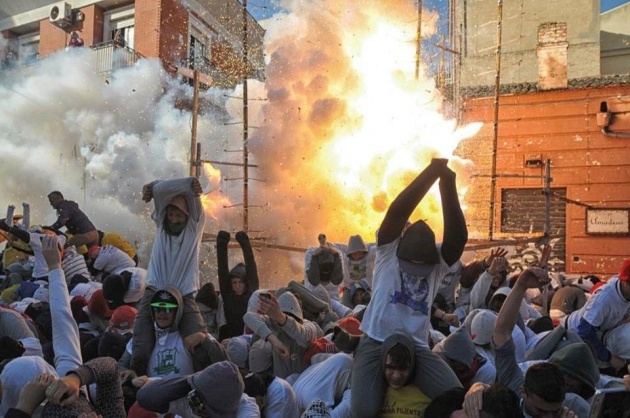
Credits: Pixor Via bitlanders
On the final note
Sometimes people do weird things: surfing among the sharks, run with the bulls, run next to the fireworks or flagellate themselves. Apparently, things like these are something illogical and, maybe, several people could think that they are stupid and dangerous but, when the traditions that characterize the identity of a group of people are strong there are not logical speeches that can change their mind. Therefore, when a pagan and adrenaline tradition is strictly linked to the religious aspect, the emotive side of people is so excited that no one can resist it. In particular, during the celebrations in San Severo, every single runner feels a mixture of adrenaline, survival instinct, devotion and the will of redemption through the pain that no one person, far from the atmosphere that is breathed in the city, could understand. So, if someone someday wants to see a very crazy celebration, now you can add the one of San Severo (Italy) on your list.

Image Credits: Luca Maresca Via hiveminer
Here there's a video that shows how the fireworks are made by the artisans of San Severo.
Video Credits: Pyromovies HD Via YouTube
Thanks for reading, my friends. I hope to see you here someday.
Here, there is a Querlo Chat which you could find useful.
▓▄▀▄▓▀▄▀▓▄▀▄▓▀▄▀▓
Written for Bitlanders
by Pixor
Thanks for your attention.
Pixor, student in electronic engineering at the Polytechnic University of Bari, Italy. Curious and passionate about science, technology, animals, travels, history and music.
Here there are my BLOGS.
¤¤¤¤¤¤¤¤¤¤¤¤¤¤¤¤¤¤¤¤¤¤¤¤¤¤¤¤¤¤¤¤¤¤¤¤¤¤¤¤¤¤¤¤
Do you like writing?
Do you want to become a blogger and earn from your blogs?
So, subscribe to bitlanders by clicking HERE and join our big family.
¤¤¤¤¤¤¤¤¤¤¤¤¤¤¤¤¤¤¤¤¤¤¤¤¤¤¤¤¤¤¤¤¤¤¤¤¤¤¤¤¤¤¤¤
You may also read:
• Holidays in Apulia: what to see, where to go, what to know
• The Majorana particle finally captured. What will happen now?
• Graphene: the material of wonders
• Enigma: the story of the cipher machine that changed the world



